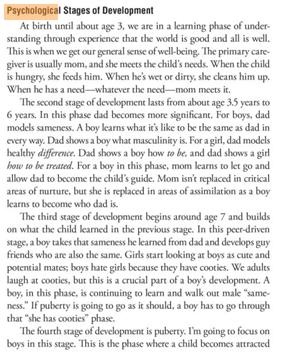The APA released the report from the Task Force on Appropriate Therapeutic Responses to Sexual Orientation today. This post is the APA press release, I also have an analysis of the report and another post coming with press reports.
APA PRESS RELEASE
August 5, 2009
Contact: Kim Mills
(202) 336-6048 until Aug. 5
(416) 585-3800 – Aug. 5-9
——————————————————————————–
INSUFFICIENT EVIDENCE THAT SEXUAL ORIENTATION CHANGE EFFORTS WORK, SAYS APA
Practitioners Should Avoid Telling Clients They Can Change from Gay to Straight
——————————————————————————–
TORONTO—The American Psychological Association adopted a resolution Wednesday stating that mental health professionals should avoid telling clients that they can change their sexual orientation through therapy or other treatments.
The “Resolution on Appropriate Affirmative Responses to Sexual Orientation Distress and Change Efforts” also advises that parents, guardians, young people and their families avoid sexual orientation treatments that portray homosexuality as a mental illness or developmental disorder and instead seek psychotherapy, social support and educational services “that provide accurate information on sexual orientation and sexuality, increase family and school support and reduce rejection of sexual minority youth.”
The approval, by APA’s governing Council of Representatives, came at APA’s annual convention, during which a task force presented a report that in part examined the efficacy of so-called “reparative therapy,” or sexual orientation change efforts (SOCE).
“Contrary to claims of sexual orientation change advocates and practitioners, there is insufficient evidence to support the use of psychological interventions to change sexual orientation,” said Judith M. Glassgold, PsyD, chair of the task force. “Scientifically rigorous older studies in this area found that sexual orientation was unlikely to change due to efforts designed for this purpose. Contrary to the claims of SOCE practitioners and advocates, recent research studies do not provide evidence of sexual orientation change as the research methods are inadequate to determine the effectiveness of these interventions.” Glassgold added: “At most, certain studies suggested that some individuals learned how to ignore or not act on their homosexual attractions. Yet, these studies did not indicate for whom this was possible, how long it lasted or its long-term mental health effects. Also, this result was much less likely to be true for people who started out only attracted to people of the same sex.”
Based on this review, the task force recommended that mental health professionals avoid misrepresenting the efficacy of sexual orientation change efforts when providing assistance to people distressed about their own or others’ sexual orientation.
APA appointed the six-member Task Force on Appropriate Therapeutic Responses to Sexual Orientation in 2007 to review and update APA’s 1997 resolution, “Appropriate Therapeutic Responses to Sexual Orientation,” and to generate a report. APA was concerned about ongoing efforts to promote the notion that sexual orientation can be changed through psychotherapy or approaches that mischaracterize homosexuality as a mental disorder.
The task force examined the peer-reviewed journal articles in English from 1960 to 2007, which included 83 studies. Most of the studies were conducted before 1978, and only a few had been conducted in the last 10 years. The group also reviewed the recent literature on the psychology of sexual orientation.
“Unfortunately, much of the research in the area of sexual orientation change contains serious design flaws,” Glassgold said. “Few studies could be considered methodologically sound and none systematically evaluated potential harms.”
As to the issue of possible harm, the task force was unable to reach any conclusion regarding the efficacy or safety of any of the recent studies of SOCE: “There are no methodologically sound studies of recent SOCE that would enable the task force to make a definitive statement about whether or not recent SOCE is safe or harmful and for whom,” according to the report.
“Without such information, psychologists cannot predict the impact of these treatments and need to be very cautious, given that some qualitative research suggests the potential for harm,” Glassgold said. “Practitioners can assist clients through therapies that do not attempt to change sexual orientation, but rather involve acceptance, support and identity exploration and development without imposing a specific identity outcome.”
As part of its report, the task force identified that some clients seeking to change their sexual orientation may be in distress because of a conflict between their sexual orientation and religious beliefs. The task force recommended that licensed mental health care providers treating such clients help them “explore possible life paths that address the reality of their sexual orientation, reduce the stigma associated with homosexuality, respect the client’s religious beliefs, and consider possibilities for a religiously and spiritually meaningful and rewarding life.”
“In other words,” Glassgold said, “we recommend that psychologists be completely honest about the likelihood of sexual orientation change, and that they help clients explore their assumptions and goals with respect to both religion and sexuality.”
A copy of the task force report may be obtained from APA’s Public Affairs Office or at http://www.apa.org/pi/lgbc/publications/therapeutic-response.pdf.
Members of the APA Task Force on Appropriate Therapeutic Responses to Sexual Orientation:
Judith M. Glassgold, PsyD, Rutgers University – Chair
Lee Beckstead, PhD
Jack Drescher, MD
Beverly Greene, PhD, St. John’s University
Robin Lin Miller, PhD, Michigan State University
Roger L. Worthington, PhD, University of Missouri
The American Psychological Association, in Washington, D.C., is the largest scientific and professional organization representing psychology in the United States and is the world’s largest association of psychologists. APA’s membership includes more than 150,000 researchers, educators, clinicians, consultants and students. Through its divisions in 54 subfields of psychology and affiliations with 60 state, territorial and Canadian provincial associations, APA works to advance psychology as a science, as a profession and as a means of promoting health, education and human welfare.
# # #
